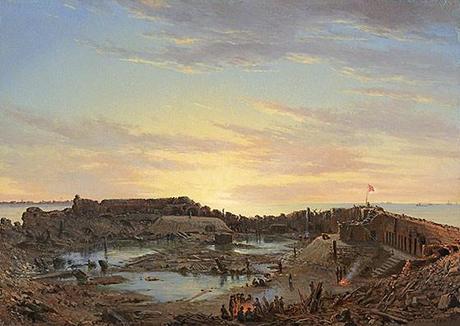This blog post is part of a monthly Eye Level feature on our exhibition The Civil War and American Art. Curator Eleanor Harvey talks about many of the important intersections between American art and the Civil War. The exhibition runs through April 28, 2013.
Conrad Wise Chapman may be the least well-known painter included in The Civil War and American Art, and not surprisingly he's the artist most visitors have asked me about. His small paintings of the battlements surrounding Charleston Harbor are beautifully composed and painted, answering the artist's need to paint coastal landscapes and the Confederacy's desire for views of the city's fortifications. And therein lies one of the most significant reasons for Conrad's relative obscurity in American art—his wholehearted support for the Confederacy. In large part, Northern artists painted the works that were most widely seen and reviewed during the Civil War, as the New York-based art market hummed along relatively unscathed by the conflict. Across the South, however, the war took a dreadful toll on the fine arts. Blockades impeded the availability of supplies; scarcity of money drained patronage from the art market; and even in Charleston and New Orleans, two of the most vibrant economies in the South, the art market essentially went dormant.
Conrad Wise Chapman defied his family and enlisted when war broke out. Although he was raised in Italy, Conrad considered himself first and always a Virginian. His middle name honored Virginia Governor Henry A. Wise, who became Chapman's commanding officer in the Confederate army.
Chapman was able to take advantage of a rare moment during the war. Stationed in Charleston under the direction of General P. G. T. Beauregard, Chapman was assigned to paint the fortifications Beauregard had labored to rebuild as illustrations for his planned memoir. Between December 1863 and March 1864 Chapman rowed across the harbor sketching the forts.

Conrad Wise Chapman, Fort Sumter, Interior, Sunrise, Dec. 9, 1863, 1863–1863, oil on board, The Museum of the Confederacy, Richmond, Virginia, Photography by Alan Thompson
One of the most poignant and lyrical of Chapman's paintings is Fort Sumter, Interior, Sunrise, Dec. 9 1863. As dawn rises over the scene, groups of men huddle around small fires, the light reflected in pools of standing water inside the shattered battlements. Chapman had been raised in Rome, and his vision of Sumter is steeped in childhood memories of the Coliseum, an emblem of the fallen empire. Chapman imbues his scene with a similarly grave pathos, as though portraying a similarly embattled civilization. Atop one of the damaged walls, a Confederate flag flies proudly in the morning light, a sentry perched close by. That flag was the centerpiece of another painting, titled The Flag of Sumter, Oct 20 1863, in which the banner waves defiantly as the Union navy anchors outside the harbor. During 1863 Federal forces tried without success to penetrate Charleston Harbor. Partially in frustration, the Union ships daily fired upon Sumter and its large Confederate flag, a lingering reminder of the insult to the American flag that Major Robert Anderson had lowered in surrender in April 1861. Overnight the Confederate soldiers would repair the flagpole and run up the colors each morning. Chapman painted this symbolic gesture of stubborn pride in the Confederate cause.
Chapman ended up painting thirty-one views of Charleston Harbor, nine of which are included in this exhibition. With the surrender of the Confederacy, Chapman had no one to buy the works or publish them. (Beauregard's memoir never came to fruition.) As late as 1898 the entire suite of paintings went on view at the Union League Club in New York, where they attracted attention, but no buyers. Governor Wise's son John noted bitterly—and quite possibly correctly—that this was due to the prominence of the Confederate flag in many of the paintings. The following year the Chapman family finally found a sympathetic buyer and sold the set to Richmond native Granville Valentine. Tucked away in his private collection and eventually donated to The Museum of the Confederacy in Richmond, Virginia, Chapman's paintings remained mostly unknown.
Chapman's career highlights the extreme difficulty of sustaining an artistic career in the war-torn South. Chapman's works were evidence of a gamble that, should the South prevail, victory might have positioned him to be an artist of some repute. Instead he struggled to obtain the commissions necessary to sustain his career and his family. Conrad's experiences provide an illuminating case of how historical circumstance can trump aesthetic merit. His small, lyrical views of Charleston provide an important insight into the power of art both to document and transcend the conflict.

